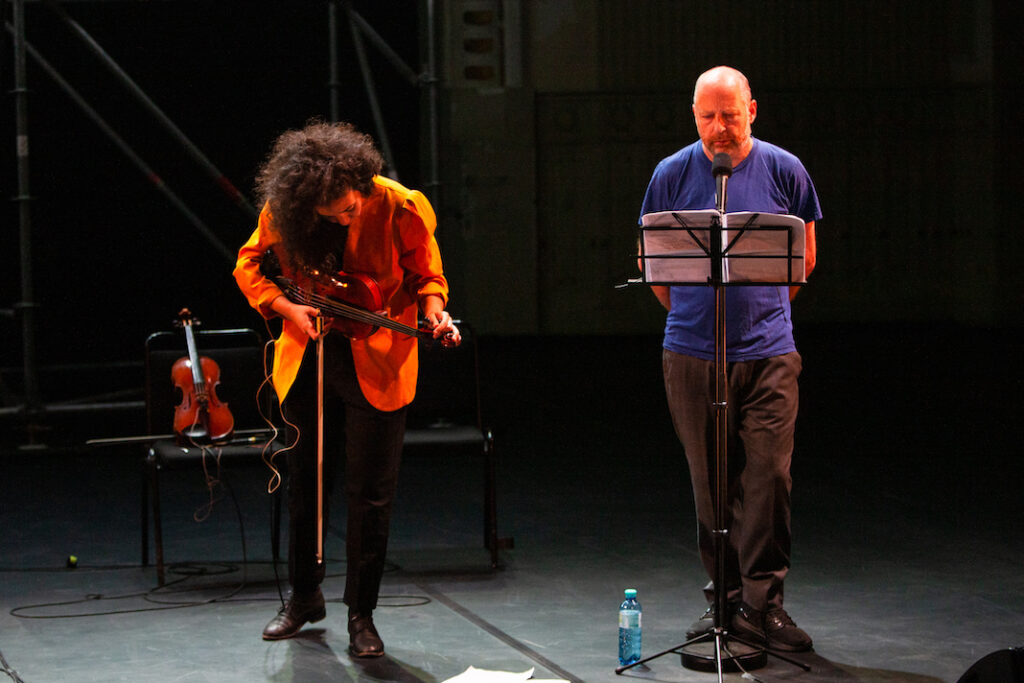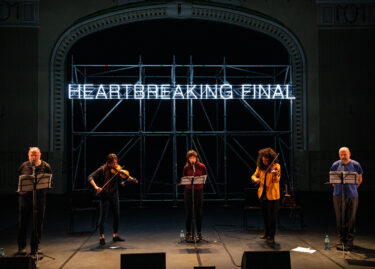
Tim Etchells and Aisha Orazbayeva, in conversation with artist Vlatka Horvat about their text and music performance collaboration Heartbreaking Final (2021).
VH: You’ve been improvising together as a duo for some years now – what was the impulse for developing this larger collaboration?
TE: Most of what we’ve done as a duo has been pure improvisation – me working with text fragments pulled instantly from my notebook, Aisha proceeding from quite immediate impulses or discoveries regards violin material. The idea here was to make something with more structure, a planned longer-form work that has a clearer focused sense of itself and a dramaturgy in text terms and in musical terms. It relates to the work we’ve done before – there are approaches we’ve developed which we continue to draw on – but the challenges and the opportunities are quite different.
AO: When you are trapped in a limitation of a single violin against the stories, the narratives, the images of Tim’s words and his voice – you begin to look for all the possible ways out of that single violin voice, so it stops being just a violin. We discover a lot of unexpected ways to connect, to find and to replace each other in that process of escaping. As much as I enjoy it, the downside is not being able to develop the material fully, it’s like walking on the edge of a forest but never going in.
TE: Working together but with other performers in the room too is also something new – having John, Nicki, and Chihiro in the mix brings unexpected energies and understandings into play.
VH: In terms of instruments, Aisha you’ve constructed this piece for two violins – what’s your attraction to this doubling or dialogue?
AO: Working with Tim started me off on an improvisation/composition route where I’d spend more and more time experimenting with different violin sounds and I feel like I know the violin sound world better than any other instrument. I always tried to have “multiple” voices happening when improvising with Tim and I often wished there was one more person sharing a voice to make the texture richer, more complex.
VH: What about the decision to explore multiple speaking/performing voices in this work – is the motivation similar?
TE: Yes, my thinking relates to Aisha’s – in the duet work I’ve always enjoyed the way that the speaking voice is texture, energy, sound: musicality as well as semantics. And I’ve been interested to extend that understanding of the voice. Creating something for three voices allows me to play with overlapping layers of speech and with the device of interspersing or intercutting words and phrases from different speakers – there’s the possibility for sense, but also new possibilities for noise and for non-sense as well as a chance to create new, less straightforward, or obvious kinds of meaning. In performance terms I’m fascinated by energy or focus imbalance and by processes of transformation – how something playful becomes something serious, how something comical becomes upsetting – having three voices in the mix creates the possibility to work with different impulses at the same time. There are moments in the performance when one of us is very soft, and another will be very agitated or combative with the text, the two moods in a kind of unresolvable relation.
VH: Thinking about those kind of counterpoints – how much of Heartbreaking Final is improvised? Are there scored elements? What form does the score take?
AO: For both the music and the voice there are elements that are fixed, decisions that are made in advance but within that frame there is room for improvisation. Musically there are scored elements to give general information about each piece like pitch, metre, rhythmic patterns, technique, any specific preparation, timings. It is mostly a text-based score which is half-notated in Sibelius.
VH: I was thinking about the relationship between voice/text and the musical elements of the piece, how they meet each other. What are the opportunities of working between words and music? And what are the pitfalls? Are there things you try to avoid?
AO: We aim for a relationship where the two are equal and where the roles are sometimes swapped, sounds becoming more like speech patterns with words getting closer to music. But also, at times the text and the sound don’t belong together, they stand apart. It’s always in motion – the text and the violin sound try to be together; they are together, they cover each other up and one becomes inaudible. Above all we try to avoid a scenario where music acts as an accompaniment to the text. From my experience that lack of hierarchy can be difficult to achieve because words are easier to hold on to, I find that in almost anything as soon as you hear someone speak your focus shifts.
VH: Tim, how do you see the relation between Heartbreaking Final and your other performance work, with Forced Entertainment or in other contexts?
TE: There’s certainly a shared ground. My interest is always chiefly in the live unfolding and negotiation of something in public – playing with the flow of information over time, with the shifting relation to the viewer, between intimacy and distance. And language itself has been a constant preoccupation – how to work with text and at the same time question, undermine or reveal its authority, its power to frame and fix meaning. Lots of the projects with Forced Entertainment have those goals. There’s tactical common ground too – the bare, straightforward set up for the performance, the use of listing and repetition are things that characterise a lot of my work. The biggest connection though is probably to my work with language in an art context. In the neon, LED sculptures and other text works I’ve been doing since 2007 there’s often an insistence on a single phrase or fragment – a line taken out of context that one has to see and see again, each moment of looking at it opening other readings or interpretations. The work in Heartbreaking Final performs a similar insistence at times, not turning a single phrase into a material object but into a sonic and temporal one, something that has to be heard and heard again. The effect is to open space for the audience, a space of imagination, contemplation – that’s another shared ground in this work.
VH: Aisha, as an instrumentalist you draw on a wide range of repertoire – what do you bring with you into a project like this one? Not influences as such – but ways of thinking or doing?
AO: Working with repertoire from Early Music to contemporary avant garde teaches you many ways of thinking and approaching music and sound. That exposure influences the way you think, the way you hear and the way you internalise music. You bring an open mind to a project like this. Also, stylistically it opens up possibilities where you can go from a single scrape or white noise polluted texture of an overpressed bow to something very fragile, melodic or 400 years old that’s coming to us through cracks of a battered bow.
VH: What holds it together? Do you think about there being a narrative shape to the work? A thematic?
TE: There’s not a narrative. What unfolds is the text, the music. You’re watching the five of us dealing with and negotiating the material of different kinds, it’s a task. That connects to aspects of my work with Forced Entertainment of course but there’s a new liberation in this piece – it deals with a different kind of journey, a sonic, emotional one rather than a dramatic one. As text-performers we’re also musicians, with the additional nuance of course that the text is always producing ideas, questions and images. I think what holds the whole thing together is a movement back and forth between interior and exterior – there’s a lot of material that feels like stream of consciousness, very internal, self-description or self-narration and then other material that’s much more exterior – images that give a sense of a larger world: landscapes, cities, people. We didn’t set out to create something that mapped into the last 18 months, the pandemic, the simultaneous sense of isolation and global connection that it has produced – but of course that’s the context in which we’ve been developing the material though this time. Thinking about the piece now I feel that strongly – it seems absolutely grounded in this strange stasis, this space of uncertainty and potential.
Vlatka Horvat (1974 in Čakovec, Croatia) works across sculpture, installation, drawing, performance, photography, video and writing. Her work is presented internationally in a variety of contexts – in museums and galleries, theatre and dance festivals and in public space. After 20 years in the US, she currently lives in London.
 Heartbreaking Final, 2021
Heartbreaking Final, 2021